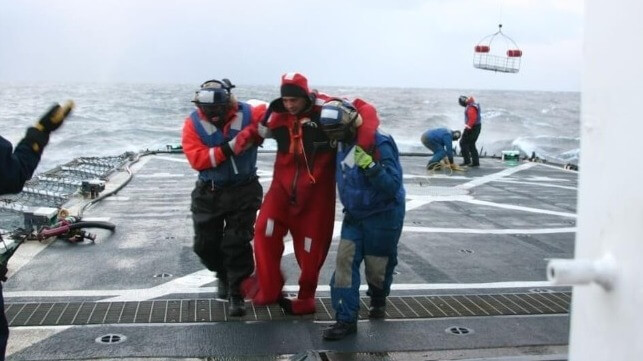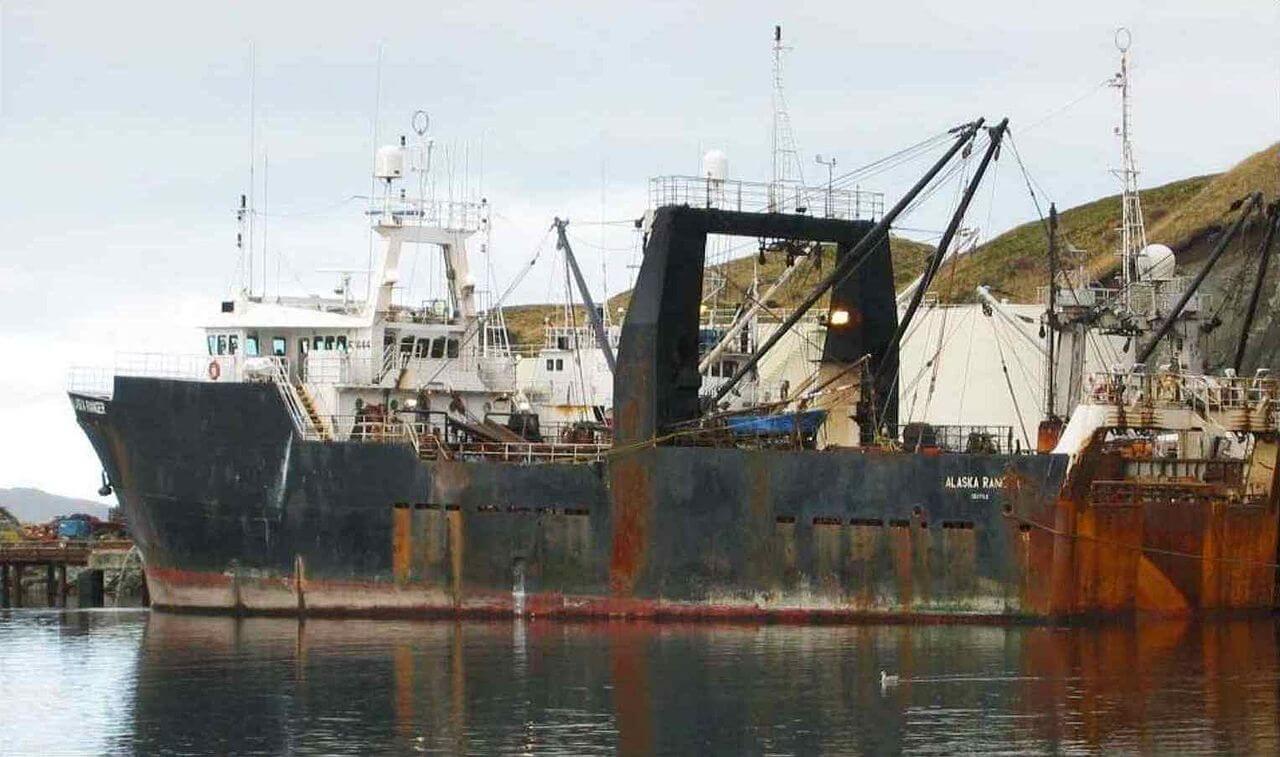Miraculous Rescue: Remembering the Alaska Ranger

[By Petty Officer 1st Class Richard W. Brahm, United States Coast Guard]
Mayday, mayday, mayday. United States Coast Guard, this is the Alaska Ranger. Our position is 5-3-5-3 decimal 4 north, 1-6-9-5-8 west. We are flooding; taking on water in our rudder room.
On Easter morning in 2008 at approximately 0300, the fishing vessel Alaska Ranger’s mayday call raced across radio waves of the Bering Sea. Forty-seven fishermen aboard the Alaska Ranger were donning survival suits for what would become one of the largest and most dramatic rescue cases in modern Coast Guard history.
At the time, the Coast Guard Cutter Munro was on patrol near the Bering Sea fishing fleet. With the wind at its back, Munro was in the best position to respond rapidly to any vessels in distress.
The Alaska Ranger was located 120 miles west of Dutch Harbor, Alaska, and enduring blistering gale force winds, temperatures below freezing and seas swelling from 10 to 20 feet. For days before its mayday call, the fishing vessel had been forcing its way through destructive pack ice. Very early on March 23, without any warning, frigid water began rushing into the ship’s rudder room, flooding adjoining spaces and disabling the ship. The Alaska Ranger lost steering and power, and was at the mercy of the unforgiving Bering Sea.
 Alaska Ranger (NTSB)
Alaska Ranger (NTSB)
Soon after the flooding began, the captain of the Alaska Ranger made two calls that saved the lives of nearly everyone aboard. The first was to order his crew to quickly don survival suits, deploy as many life rafts as possible and abandon ship. The second was his mayday call to the Coast Guard.
On board Munro, it was just after 3:00 a.m., when the commanding officer, Capt. Craig Lloyd, heard the mayday call. At the time, red lights illuminated the ship’s corridors and the hum of diesel engines created a soothing lullaby for those aboard. Most of the cutter’s crew was asleep even though the same seas and howling wind that rocked the Alaska Ranger were rocking their cutter.
Lloyd ordered the cutter about to Alaska Ranger’s last known position. Meanwhile, the officer-of-the-deck plotted the fastest course to the foundering vessel and ordered the engine room to take the diesels offline and turn on the ship’s powerful gas turbine engines. The engine room crew tweaked the gas turbines pushing them for everything they had. The cutter would soon reach speeds unheard of on board an ordinary high-endurance cutter.
When Munro neared the fishing vessel’s position, Lloyd interrupted the rocking calm with the crackle of the ship’s intercom and his booming voice. Listening intently as Lloyd described the situation; the crew began rolling out of their racks and kicked into action. Crewmembers rushed to their assigned areas, scurrying through tight quarters and going up and down ladders. They prepared to take on survivors by converting the mess deck into a treatment center, heating blankets in ovens, breaking out survival gear, and getting the flight deck cleared to launch the cutter’s HH-65 Dolphin helicopter.
Hundreds of miles away, the crew of a Coast Guard HH-60 Jayhawk stationed at St. Paul Island, Alaska, located in the middle of the Bering Sea, awoke to a ringing phone. Pilots and aircrew members bolted to the locker room to dress-out in survival gear. Ground support jumped in vehicles and sped over to the hanger where they prepped the helicopter for takeoff. The aircrew gathered as much last minute information as they could before driving over to the hanger.
Once airborne, the Jayhawk’s two pilots, Lt. Brian McLaughlin and Lt. Steve Bonn, slid night-vision goggles into place from atop their helmets. Meanwhile, the crew in back, Petty Officer 2nd Class Robert DeBolt, an aviation mechanics technician, and Petty Officer 2nd Class O’Brien Hollow, the helicopter rescue swimmer, called on the radio to the Alaska Ranger. The night was pitch black and the only thing visible for the helicopter crew, between the barrages of snow, was the inky blackness of the vast ocean.
McLaughlin later recalled, “As the helicopter approached the Alaska Ranger, before it had sunk, we were able to reach them on the radio about 30 miles north of their position. The concern in the voice on the other end of the radio was palpable and filled our aircraft with the looming dread that what we were heading for was very real. The good news was that everyone had been able to don their survival suits before abandoning ship. They stated there were only seven people left aboard and they were getting ready to get into the rafts.”
As the Jayhawk neared the scene, the crew saw three strobe lights blinking on the horizon and figured those were the rafts. As they got closer, there was a fourth light, then a fifth, and a sixth, and so on. It soon became apparent that there were dozens of victims scattered across the water in addition to the rafts.
The pilots climbed the Jayhawk higher to see farther. The first strobe lights the helicopter had overflown were a pair of victims in survival suits waving at them. However, from the higher altitude, they could see lights flashing over a mile-long stretch with the Alaska Ranger nowhere in sight. The crew decided to hoist victims from the water first, not those afloat in rafts.
McLaughlin remembered, “We just picked a spot and began hoisting. I called the one raft that had a handheld radio and explained to them what we were doing while the rest of my crew was busy getting the rescue swimmer out the door.”
Hollow’s work came into play immediately. One of his jobs as a rescue swimmer was to enter the freezing water under unrelenting rotor wash in high seas, and pluck victims from the water. As the flight mechanic, DeBolt and Hollow had practiced this operation countless times. DeBolt checked Hollow’s gear one last time before lowering him down to the roiling seas. Hollow slid to the edge of the helicopter’s open door as snow and sea spray swirled around him.
During this recovery operation, Hollow knew it would take too long to fit nearly frozen survivors into a rescue basket. Instead, he grabbed each one and held them while still attached to the hoist cable using a technique called “sling augmented double pickup.” McLaughlin later recounted that in less than an hour “we would pick 12 people out of the water and stack them in the cabin, while trying to coordinate an offload with their sister ship, the Alaska Warrior, as it was only five miles away.”
The Jayhawk aircrew was ready to deposit the survivors aboard Alaska Warrior, but there was a problem. The helicopter crew was unaware of the fishing gear and rigging on board the fishing vessel. Once the helicopter made it to the Alaska Warrior, the aircrew knew it would be impossible to lower survivors down to it. The HH-60 crew also had to manage its fuel supply. There were two choices: fly to Dutch Harbor, drop off the survivors and try to refuel there, or the Jayhawk could land on Cutter Munro. If it did the latter, the helicopter could deposit the survivors and perform an in-flight refueling from the cutter. The crew decided to fly to Munro.
The corpsmen aboard the Munro and support crewmembers had been working hard turning the mess deck into a triage and hypothermia treatment center. By the time McLaughlin’s Jayhawk picked up its last victim, Munro’s HH-65 Dolphin had already launched. About 20 minutes later, the Jayhawk arrived at Munro and began lowering survivors to the deck. Munro’s crew knew the longer it took to get survivors inside, the longer victims left behind had to survive in the water. With barely enough light to see, Munro’s crewmembers waited in the early dawn as the hoist cable lowered survivors down one at a time.
One by one, survivors were taken to Munro’s makeshift triage center where the crew provided them heated blankets and dry clothes.
 Survivors were provided with care in USCGC Munro's mess deck (USCG)
Survivors were provided with care in USCGC Munro's mess deck (USCG)
“The speed and safety with which the Munro’s crew transferred the survivors out of the basket and got ready for the next one was phenomenal,” said McLaughlin.
After clearing survivors from the flight deck, Munro’s crew shifted to in-flight refueling. DeBolt lowered the hoist cable to the cutter’s refueling team, which attached a hose and watched it hoisted up to the helicopter.
Meanwhile, Munro’s ship-deployed Dolphin helicopter, piloted by Lieutenants Greg Gedemer and T.J. Schmitz, was on-scene retrieving victims. The Alaska Ranger’s crewmembers had been in the water for a while and all of them were suffering from hypothermia. The seas reached 20 feet and the 30 mile-an-hour wind whipped cold ocean spray. Dolphin flight mechanic, Petty Officer 2nd Class Al Musgrave, lowered rescue swimmer Petty Officer 3rd Class Abram Heller to the water where he began untangling a group of five survivors from floating debris and nets. One by one, Musgrave hoisted the victims up from the water to the Dolphin.
After the victims were hoisted into the Dolphin, Heller stayed in the water. He and his aircrew decided in advance to leave him at the scene to fit an extra survivor into the Dolphin and Heller could assist those left behind. As Musgrave hoisted the last man into the helicopter, the pilots knew they had no choice but to return to Munro to refuel. Moreover, they had to hurry or run out of fuel before they got there.
Back on board Munro, the Jayhawk helicopter was over halfway refueled when the Dolphin crew radioed it was returning. It would take 20 minutes to fly back to Munro, and the Dolphin would run out of gas 10 minutes after that. Jayhawk pilots McLaughlin and Bonn knew what was at stake and made some quick calculations. They determined that they already had enough fuel to search for more survivors and allow the Dolphin to land on the Munro, disembark its survivors and refuel. In the Jayhawk, DeBolt shut off the fuel line, disconnected it from the helicopter, reattached it to the hoist cable and lowered it to Munro’s flight crew.
The Jayhawk departed into the darkness and disappeared in the direction of the remaining victims. As Bonn flew into the endless night, he thought about the men struggling to survive in the bone-chilling water and how his helicopter was their last hope. By the time the Jayhawk arrived at the scene, Alaska Warrior had retrieved 22 survivors. The Jayhawk recovered four more victims as well as Dolphin’s rescue swimmer, Heller. The Jayhawk continued searching until it ran low on fuel. Bonn turned the helicopter back to Munro to offload his survivors and Heller, refuel and then headed back to St. Paul Island.
Employing a total of five aircraft (including support aircraft), seven aircrews, a Coast Guard cutter and a local Good Samaritan vessel, the Alaska Ranger rescue proved the largest Coast Guard operation of its kind in recent years. The Coast Guard helped save 42 lives that night and, although the Alaska Ranger case had many complexities, the Coast Guard’s well-trained men and women were ready.
This article appears courtesy of The Long Blue Line and is reproduced here in an abbreviated form. The original may be found here.
The opinions expressed herein are the author's and not necessarily those of The Maritime Executive.
